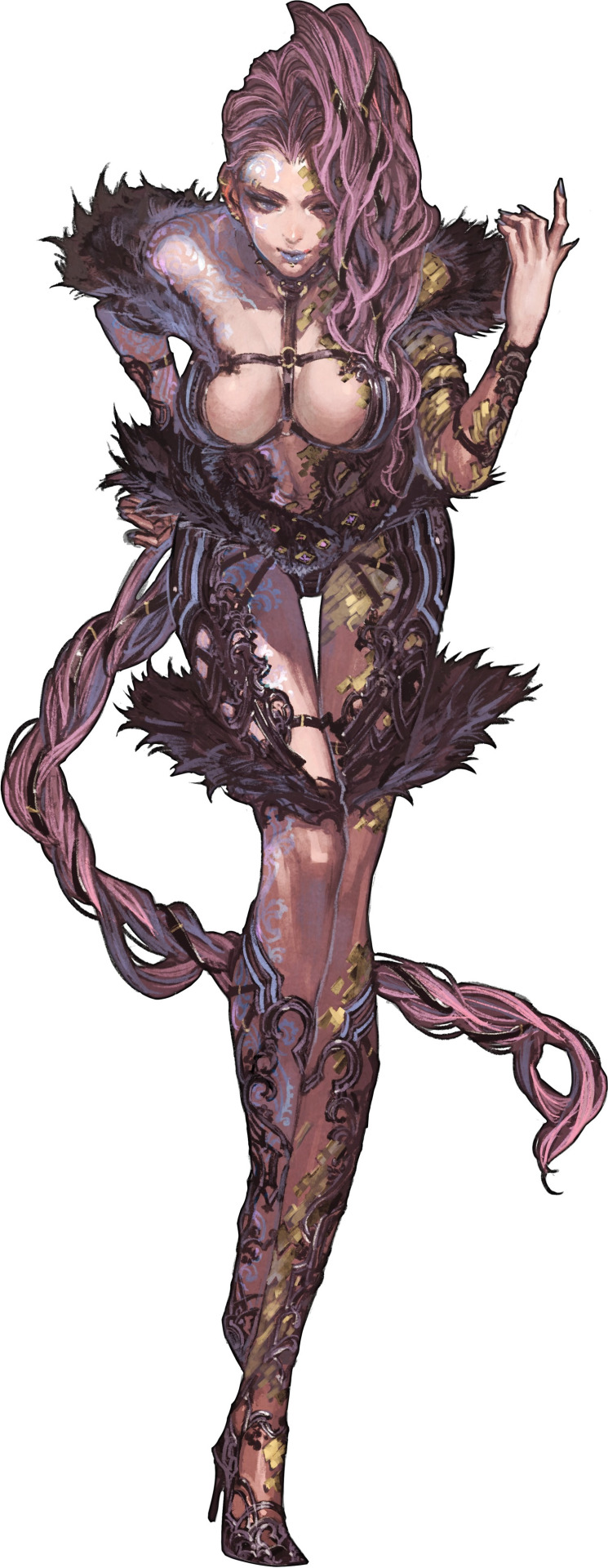#brigandine
Text

All girls dungeon squad! by HanPixe
#HanPixe#the party#greatsword#longbow#spear#shield#sword#chainmail#helmet#brigandine#hood#tankard#fighter#barbarian#ranger#cleric
292 notes
·
View notes
Photo
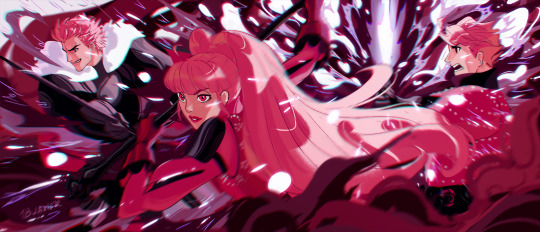
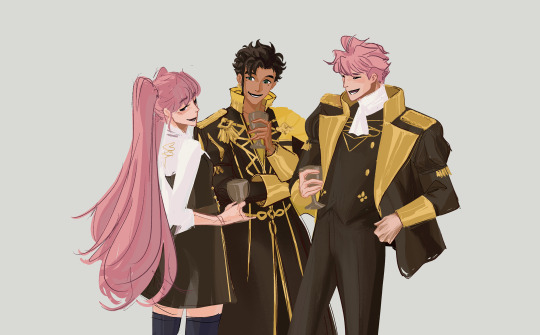
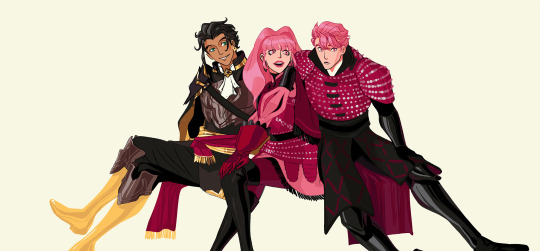

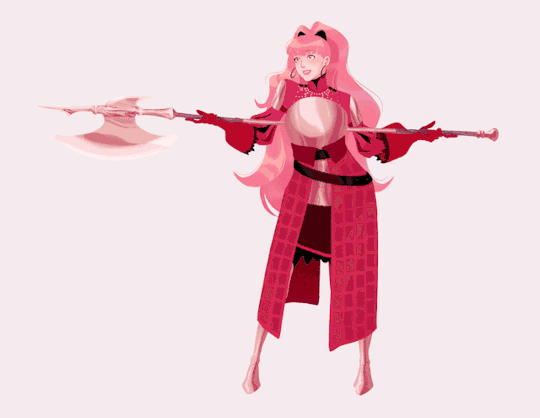
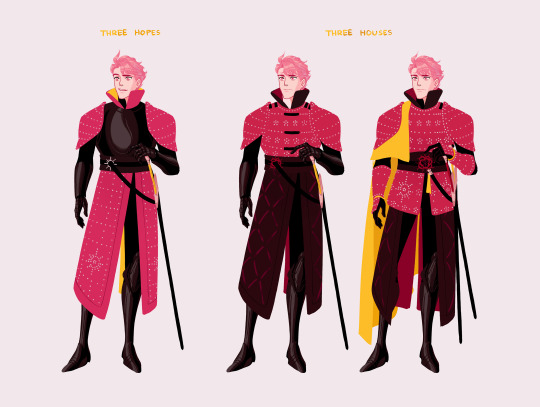
FE3H dump / Pushing my Hilda in Brigandine agenda.
I love drawing Hilda with a wild-ness to her hair, it’s mused from all the fighting. But in a fabulous way. She has accounted for it.
Was already re-designing Henrik a few months ago (To match the whole Leicester designs seem to have lots of cloth on them = Leicester has textiles = Would have Brigandine idea), but only found out about the change in plot/premise of Three Hopes when the demo came out so the other drawings still use his old-new design (the middle of the three variations) 😅
#Fire Emblem#FE3H#Hilda Valentine Goneril#Henrik Goneril#Holst Goneril#What kind of name is Sigiswald#Brigandine#Claude Von Riegan#Fan art#Character Art#Character Design#Sketches#coloured sketches#Golden Deer#Fear the deer#I obviously have a favourite#It's Hilda#Hilda is my favourite#Hilda Hilda Hilda#Lots of exposed skin is my armour pet peeve#But I support having hoe armour options for fun#But if we're going that direction let the men be hoes too#They're laughing at Lorenz#I know Lorenz has good supports but he keeps annoying women
3K notes
·
View notes
Text

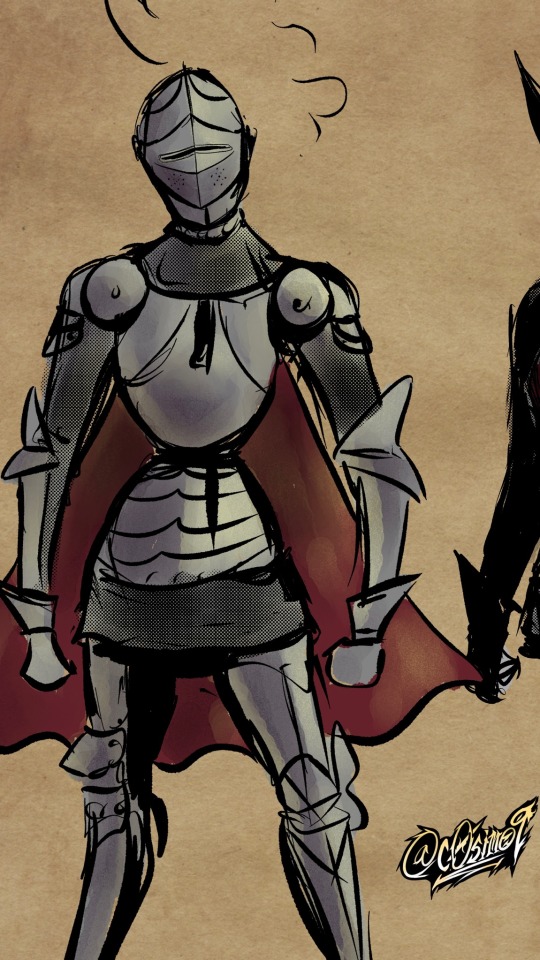
Some 15th century armor sketches
#medieval#armor#15th century#Italian armor#HEMA#kettle hat#armet#chainmail#chainmaille#maille#medieval mercenary#plate armor#xv century#brigandine#milanese#knights#knight#medieval knight#late medieval
69 notes
·
View notes
Text






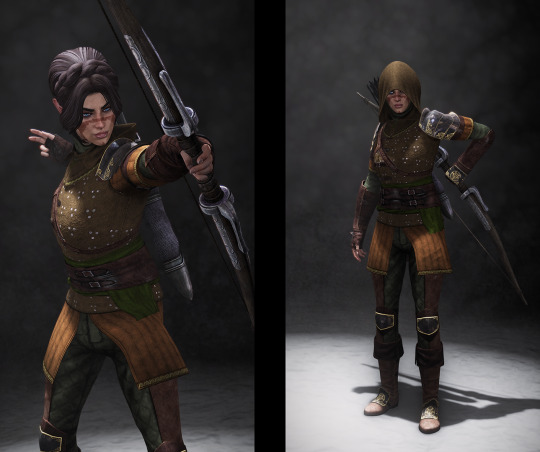
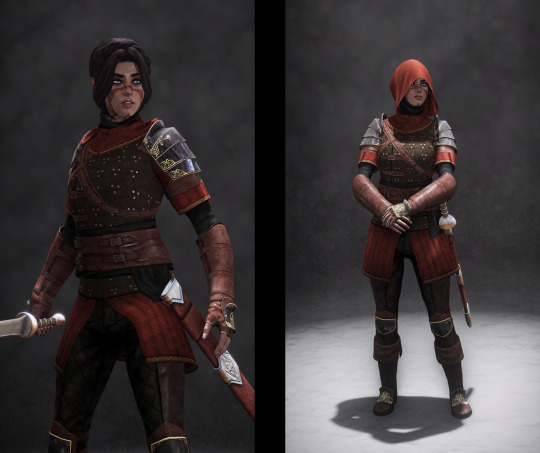




Elmlock Armor - Color Variants
Various recolors of our Elmlock Armor that can be crafted once you own the original variant.
DOWNLOAD HERE
25 notes
·
View notes
Text





Lord of Battles – 15th Century Medieval Leeds Brigandine!
In the later medieval period, brigandine armor was a common sight on men-at-arms and soldiers. Providing excellent plate-armor protection without breaking the bank, this armor was a popular choice among knights and well-heeled warriors of the time.
What made brigandine armor so practical? The overlapping plates worked together to absorb and dissipate the force of a blow, ensuring the wearer's safety. With its steel construction, the armor also offered near-immunity to cuts, making it a reliable choice for battle.
But brigandine armor wasn't just about function. Knights and warriors would showcase their status by adorning the shell backing with exotic and colorful fabrics, adding a touch of flair to their protective gear.
Step back in time and appreciate the craftsmanship and practicality of brigandine armor. Let us know your thoughts on this iconic piece of medieval history!
#Kult Of Athena#KultOfAthena#WorldOfKoa#Lord of Battles#15th Century Medieval Leeds Brigandine#Medieval Armor#Brigandine#Brigandine Scale & Lamellar#Scale Armor#Brigandine Armor#Armor#Armour#Leeds
18 notes
·
View notes
Photo

A lovely canvas covered Brigandine, Italy, ca. 1505, housed at the Castle Churburg.
117 notes
·
View notes
Photo
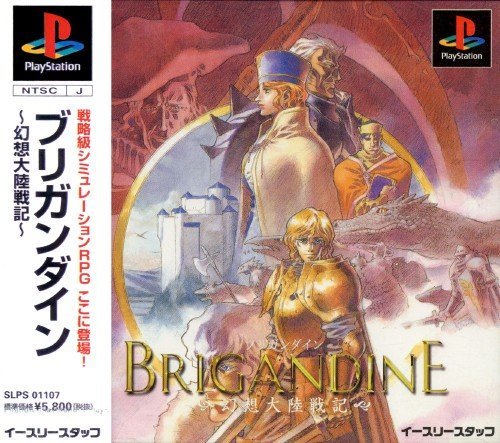
Cover of the Japanese version of the PS1 game Brigandine - Gensō Tairiku Senki / ブリガンダイン 幻想大陸戦記, AKA Brigandine: The Legend of Forsena (1998), illustrated by Nobuteru Yuuki / 結城信輝.
40 notes
·
View notes
Photo
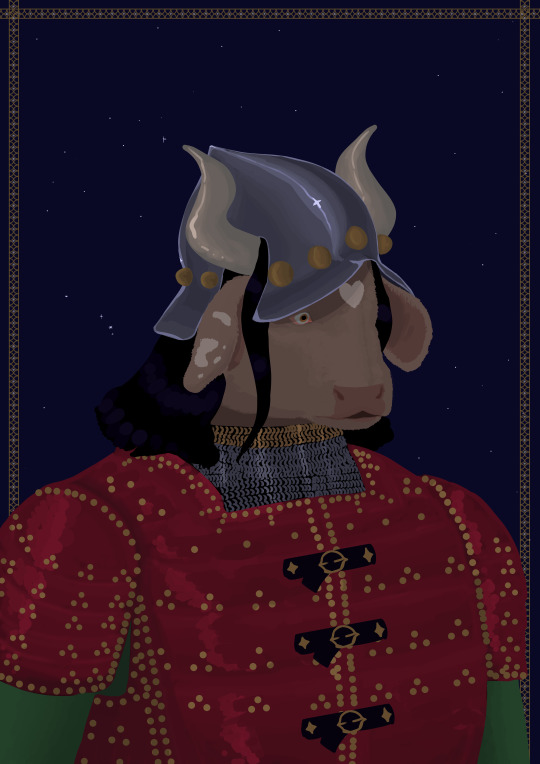
Tangier circa 1471 AD
#my art#brigandine#maille#kettle hat#pastrana#pastrana tapestries#1471#portugese#minotaur#bovine#bovid#horns#furry
22 notes
·
View notes
Text
Edens Zero Chapter 269 Livestream Discussion/Review: Swords Dance
youtube
Ziggy is engaged in combat with his son, Void while the Edens Zero continues to reach it's final countdown for destruction, and the only way to prevent this devestation is through the help of the Four Shinning Stars. Witch has currently finished off everything on her end and only Valkyrie remains in her endevours against Brigandine. At the same time, Homura is still engaged in a clash against the mother of Dragons, Acnollea.
#Edens Zero Chapter 269#Shiki Granbell#Rebecca Bluegarden#Happy#Pino#Weisz#Witch#Ivry#Hermit#Valkyrie#Ziggy#Void#Leonard#Brigandine#Killer#Acnoella#Rave Master#Fairy Tail#Edens Zero#Hiro mashima#Anime#Manga#Anime/Manga#Youtube
4 notes
·
View notes
Text

Witch-at-arms by UWU_b011
571 notes
·
View notes
Text

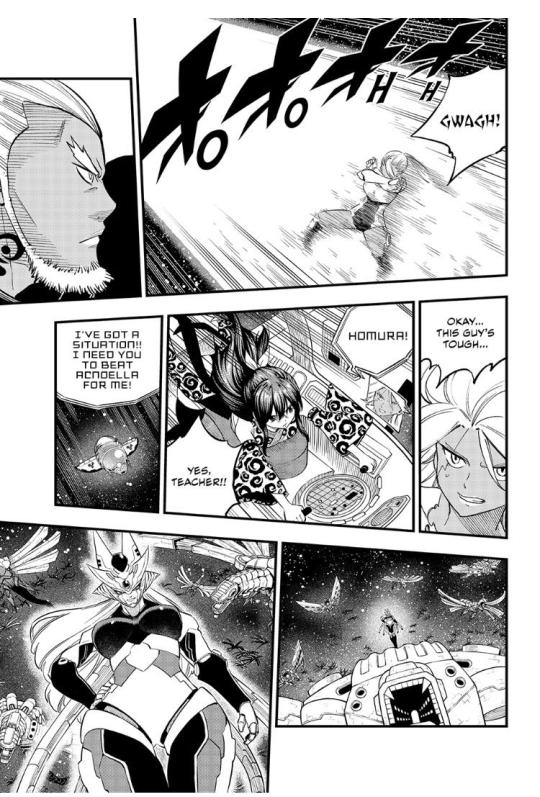

2 notes
·
View notes
Text

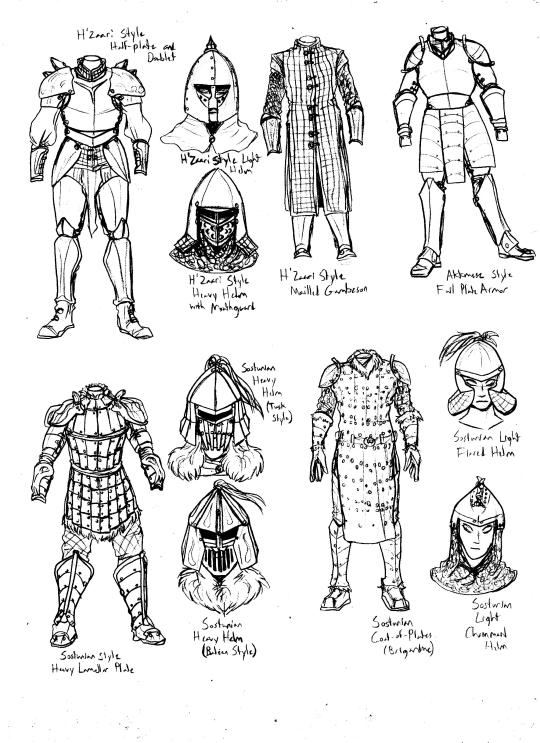
Some sketches of the look and design of a bunch of different armors in Ancardia's many cultures. This page includes all designs originating with Humans--though the armors of the Empire tend to get used by anyone happening to be living on Heartland Imperial territory. Then, more Human-centric styles, with nifty helmets to match. H'Zaari, Sostunian, and Akkmese culture distinctions make for lots of different-looking common armor. Though, I did try hard to make these as functional for protective gear as possible even with the little decorative flairs.

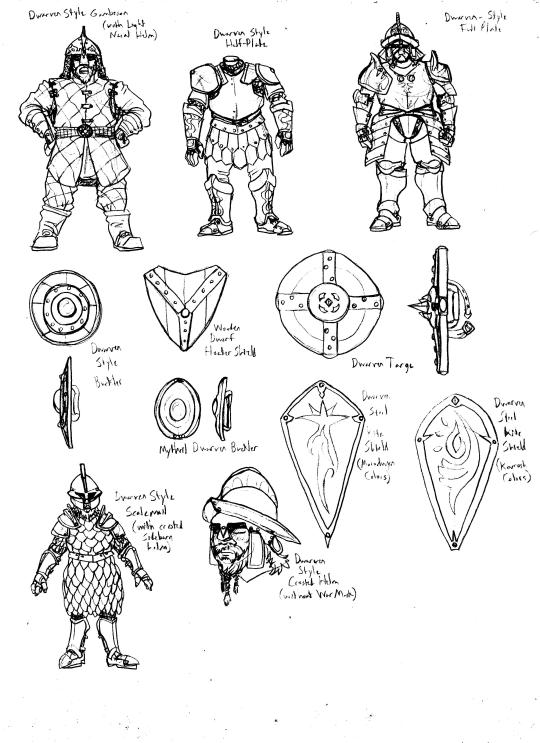
Now, for something not Human at all! This entire page shows off a range of styles and types of armor, helm and some shields made and worn by the Orcs. The Orcish culture in Ancardia is famously good at forging and smithing steel--to the point that many consider Orcish steel to be of even higher strength and durability than Dwarven steel. Likely that fact is down to the Orc-Dwarf arms' race type deal going on. Hoo dear. And of course there is also a nice page full of Dwarven designs, with particularly a lot of shields.
#armor designs#DnD#DnD homebrew#Orcish#Dwarven#Human#homebrew Human culture groups#Ancardia#Ancardia homebrew#sketches#ADOM#Ancient Domains of Mystery#plate mail#half plate#brigandine#chainmail#cloth armor#gambeson#shields
29 notes
·
View notes
Text
Playing Brigandine (again, sort of?) after all these years. I started with New Almekia because, well, I haven't played this in years and it's objectively easier.
Watching the battle between Iscalio and other nations, about a quarter of the time, is kind of a like "How DARE you hurt my blorbo" moment.
#Brigandine#Some of you have known me long enough to know who that is#but not many#Brigandine: The Legend of Forsena#Iscalio
5 notes
·
View notes
Text
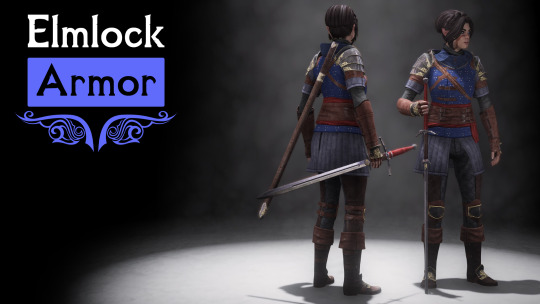

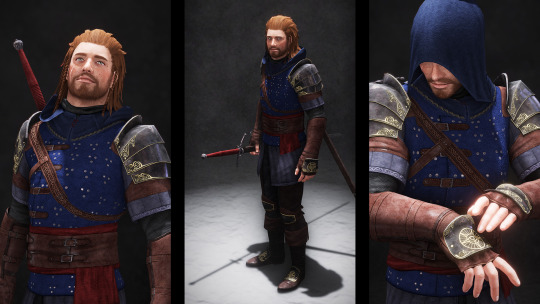
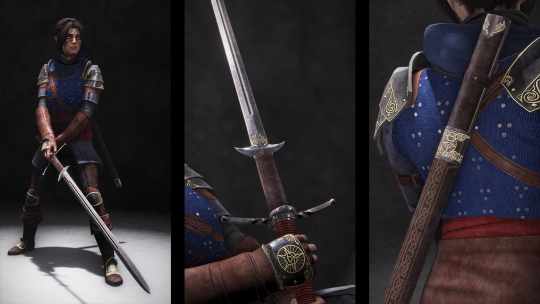
Elmlock Armor & Blade
Skyrim Special Edition mod created in collaboration with Kreiste, which adds a new set of craftable Ebony light armor and greatsword for male and female characters.
DOWNLOAD HERE
19 notes
·
View notes
Photo
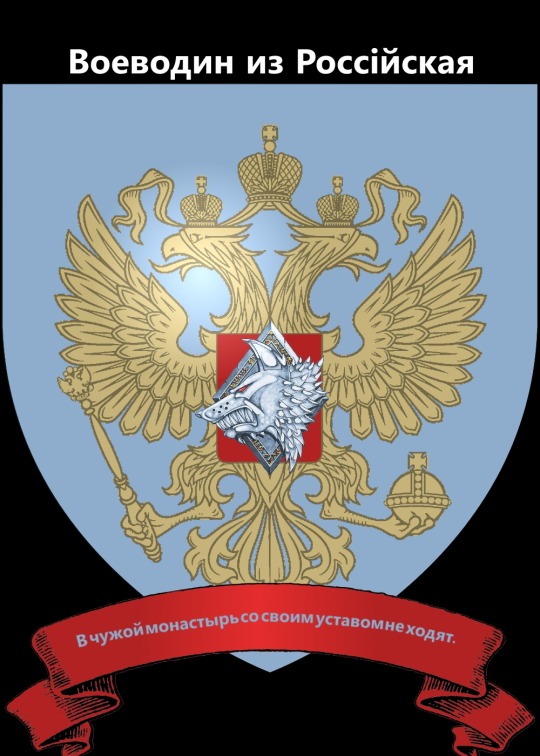

Vasily IV, second and reigning Tsar of Rus’kaya and Current Head of “Rod Vojvodin Bol'shogo” or “House Vojvodin of Bolshoi.” Vasily IV is the newly crowned and anointed “Tsar of Rus’skaya” following the passing away of his venerable grandfather and predecessor Tsar Ivan IV, the last head of House Vojvodin of Bolshoi to officially style himself “Velikiy Knyaz' Russkiy” or “Grand Prince of Rus’kaya” before his final and complete annexation of The Rivacheg Republic under the hereditary rule of Merchant Princes from a cadet branch of House Vojvodin. The hereditary, dynastic title of “Tsar of Rus’kaya” officially marking Ivan Alyeksadrovitch’s final unification of the multitude, or the plethora of Gospodar and Moravian tributary principalities based within The Vylkova Badlands. Before the formal coronation and anointment of Ivan IV as “Tsar of Rus’kaya” by The Metropolitan Patriarch of Augustgrad, the dynastic heads of the most senior branch of House Vojvodin have long held the title of “Prince of Rus’kaya” since the historic conversion of the Gospodar warchief Vasily Vojvodin to The Faith of The Old Gods by the Cosmopolitan, Classical Romulan master theologian Saint Enoch the Sufferer and the subsequent founding and construction of The Metropolitan Bishopric of Augustgrad over the consecrated site of Vasily Vojvodin’s formal conversion to The Faith of The Old Gods. The bishopric city of Augustgrad being named in honour of Augustinian Regulus, The First Cosmopolitan, Classical Romulan Imperator of Mankind in the recorded histories of “The Civilized World” and the Classical Romulan Imperator of Mankind who would eventually convert to The Faith of The Old Gods based on the canon pantheon of the Classical Mycaenean civilization autochthonous the constituent lands of the modern “Il Ducato di Messina” within the “Frivolous” or “Southern Imperial” cultural and linguistic hemisphere of The Empire of Mankind Secundus in syncretic concurrence with worship of the canon pantheon of The New Gods based on the beliefs of the younger Cosmopolitan, Classical Romulan civilization that would come to fully annex the Classical Mycaenean homeland in the formative century of The Classical Romulan Republic’s wars of conquest and expansion within The Olympian Mountain Valley. The bishopric city of Augustgrad would synonymously serve as the historic and the traditional seat of power of The Princes of Rus’kaya from House Vojvodin until it was conquered and sacked during The Kara-Khitai Invasions orchestrated under Temujin Khagan. Following the formal consecration and founding of The Metropolitan Bishopric of Augustgrad as the official seat of power for Vasily Vojvodin as The First Prince of Rus’kaya, Saint Enoch the Sufferer and his clerics and scribes would formulate both “The Enochian Script” and “The Church Gospodar Langauage” to codify and preach “The Holy Canons of The Old Gods” to the pious masses of The Church of The Old Gods in Rus’skaya. “The Enochian Script” originally formulated by Saint Enoch the Sufferer and his prelate of clerics and scribes would eventually be used to codify the written forms of the vernacular languages and cultures of the Gospodar and Moravian peoples indigenous to Rus’kaya.
Since the historic conversion of the Gospodar warchief Vasily Vojvodin to The Faith of The Old Gods by Saint Enoch the Sufferer as The First Metropolitan Patriarch of Augustgrad and his subsequent coronation as The First Prince of Rus’kaya, The Principality of Rus’kaya under House Vojvodin grew to absorb the multitude, or the plethora of Gospodar tribal chiefdoms and Moravian petty kingdoms within the Vylkova Badlands. Using the systematic, mass conversion of the Gospodar and Moravian tribes into The One True Faith of The Old Gods as the pretext, rationale, and justification for their wars of conquest and expansion within The Vylkova Badlands, any Gospodar warchiefs and Moravian petty kings who had openly refused to formally convert to The Faith of The Old Gods on behalf of their dynastic houses and their hereditary subjects were systematically overthrown by the conquering armies of The Principality of Rus’kaya and replaced by either “dynastic scions” or “legitimate issues” of House Vojvodin, who had married into the dynastic bloodlines of uncompliant Gospodar warchiefs and Moravian petty kings in order to "cement," or otherwise “legitimize” their hereditary regime and authority in the eyes of their newly conquered subjects, or “boyar” nobles and aristocrats hand picked from court favourites to The Princes of Rus’kaya seated in Augustgrad. Over the course of several centuries, many dynastic bloodlines of the original Gospodar warchiefs and Moravian petty kings who had willingly converted into The Faith of The Old Gods were eventually supplanted by “dynastic scions” or “legitimate issues” of House Vojvodin who had "coincidentally” married into their families shortly before their dynastic houses “conveniently” went extinct through the male bloodline. By the time of The Kara-Khitai Invasion of Rus’kaya under Temujin Khagan, The Principality of Rus’kaya had become a very loosely-knit confederation of highly autonomous petty principalities mostly ruled by junior and cadet branches of House Vojvodin as well as princely “great houses” of “boyar” nobles and aristocrats founded by court favourites to historic Princes of Rus’kaya, and united under the purely nominal suzerainty of The Princes of Rus’kaya from the senior branch of House Vojvodin officially seated in the bishopric city of Augustgrad. The loose autonomy of the petty principalities of Rus’kaya, coupled by the pandemic warring and political feuding between the petty princes from both junior and cadet branches of House Vojvodin as well as other princely “great houses” of “boyar” nobles and aristocrats officially founded by court favourites to historic Princes of Rus’kaya had effectively “optimized,” or otherwise “primed” the constituent lands of The Principality of Rus’kaya in The Vylkova Badlands for swift and decisive conquest and subjugation at the hands of The Kara-Khitai Horde.
Under the brilliant, ruthless, and cunning leadership of Temujin Khagan, most of the petty principalities of Rus’kaya were conquered and pillaged during the onslaught of the Kara-Khitai horde, including The Principality of Augustgrad itself, as both the traditional and the historic “demesne” or “crownlands” of The Princes of Rus’kaya from the senior branch of House Vojvodin and the episcopal diocese of The Metropolitan Bishopric of Augustgrad since the time of Saint Enoch the Sufferer, himself. Their native populations essentially becoming direct subjects to The Khan of Khans. Only the Gospodar and Moravian principalities based in the southern and western reaches of The Vylkova Badlands had finally submitted to The Khagan as tributary vassals after both realizing their inherent military weakness before, and witnessing the futility of their war efforts against The Khan of Khans. Vasily Alyeksandrovitch, the last surviving male scion of The Princes of Rus’kaya, was awarded the fertile and rich Bolshoye river valley by Temujin Khagan for his exceptional bravery, courage, and skill-at-arms in directly and personally confronting The Khan of Khans himself in single combat during the climactic Siege of Augustgrad. With the Bolshoi Kremlin becoming his new seat of power, Vasily Alyeksandrovich was subsequently awarded the title of “Grand Prince of Rus’kaya” as a grim and bitter reminder of his direct lineage to the fallen and defeated Princes of Rus’kaya formerly seated in The Metropolitan Bishopric of Augustgrad before The Kara-Khitai Invasions, as well as to distinguish his specific dynastic household from the other, more junior and cadet branches of House Vojvodin as the official collectors of taxes and tribute to The Khagans of The Kara-Khitai horde. These new “Grand Princes of Rus’kaya” directly descended from the bloodline of Vasily Alyeksandrovitch, diminutively called “The Princes of Bolshoi” by their political and military adversaries and naysayers amongst the princely, “great houses” of “boyar” and “dvoryantsvo” nobles and aristocrats would rise to become the single wealthiest and most powerful rulers amongst the tributary vassals to The Kara-Khitai Horde. Growing extremely rich serving as the official collectors of taxes and tribute to The Khan of Khans, with their already exorbitant wealth being merely bolstered and supplemented by the exceptional fertility and richness of their Bolshoye heartlands. The Grand Princes of Rus’kaya from House Vojvodin of Bolshoi would come to either absorb the constituent territories of any Rus’kayan principalities who had both openly and violently resisted their tax and tribute collections to The Khagans of The Kara-Khitai horde, or merely purchase the feudal homage and compliance of the poorer Rus’kayan princes who could not afford to pay their tribute to The Khagans. Under Alyeksandr Dmitryovitch or “Alyeksandr Donskoy,” the paternal great-grandfather of Vasily IV, The Kara-Khitai horde would suffer it’s first major, and most humiliating military defeat at the hands of the Rus’kayans at The Battle of The River Don.
With the unification of the Rus’kayan tributary principalities finally achieved under his late grandfather and predecessor. Vasily Ivanovitch as the second head of House Vojvodin of Bolshoi to officially hold the title of “Tsar of Rus’kaya” has made a point out of inviting foreign quartermasters and gunsmiths from both Le Royaume d’Aquitaine under Maison Williamson and Das Kaiserreich der Menscheit to train his seemingly backwards, yet ever growing professional army in the latest tactics and drill techniques, as well as equipping his infantry forces with the latest forms of gunpowder-based weaponry and military technology. Vasily IV as The Second and Reigning Tsar of Rus’kaya and The Current Head of House Vojvodin of Bolshoi has made a point out of arming and training newer, more professional infantry regiments of “strelets” or “shooters” with both the “bardiche,” or the Gospodar two-handed battleaxe, as well as matchlock arquebuses derived from the latest Aquitainien and Imperial models to supplement his retinues of “boyar” and “dvoryantsvo” heavy cavalry armoured in scale mail and brigandine in his bid to drive The Kara-Khitai Horde from Rus’kaya once and for all. Vasily Ivanovitch has also taken a keen interest in the latest technological developments made in gunpowder-based, siege artillery by giving expressed invitation to foreign gunsmiths from Le Royaume d’Aquitaine under Maison Williamson and Das Kaiserreich der Menscheit to disseminate the essential and necessary technical knowledge and skills to make and design gunpowder-based, siege artillery amongst the local metalsmiths of Rus’kaya Tsarstvo. By financially encouraging Aquitainien and Imperial gunsmiths to permanently set up workshop in The Principality of Bolshoi, Vasily Ivanovitch hopes to eventually outsource his antiquated arsenal of classical and feudal-age windlass artillery pieces such as catapults, trebuchets, mangonels, ballistae, and onagers with the more novel, and yet far more potent and brutally efficient gunpowder-based, siege artillery like bombards, mortars, culverins, chambered demi-canons, even the dreaded “basilisks.” Vasily IV, upon his formal coronation and anointment as The Second and Reigning Tsar of Rus’kaya and The Current Head of House Vojvodin of Bolshoi, hopes to annex the constituent territories of the petty Khanates of Northern Rus’kaya that had formed from the untimely death Yesugai Khagan at The Battle of The River Don at the hands of his great grandfather Alyeksandr Dmitryovitch. His greatest ambition as The Second and Reigning Tsar of Rus’kaya and The Current Head of House Vojvodin of Bolshoi is to reclaim The Metropolitan Bishopric of Augustgrad from The Khans of The Great Horde directly descended from Temujin Khagan, who have made House Vojvodin’s historic and traditional seat of power their home and powerbase since the climactic Siege of Augustgrad orchestrated under The Khan of Khans himself.
Inherently tied to his great push northward at the head of his heavy cavalry armies of “boyar” and “dvoryantso” nobles and aristocrats armoured in scale mail and brigandine, and supplemented by his professional, pike-and-shotte infantry regiments of strelets armed with bardiches and matchlock arquebuses. Vasily IV as The Second and Reigning Tsar of Rus’kaya and The Current Head of House Vojvodin of Bolshoi hopes to persuade The Metropolitan Patriarch of Augustgrad to permanently migrate his episcopal seat of power to House Vojvodin’s new capital in Bolshoi, finally tearing him from the authority and the influence of The Khan of The Great Horde forever. Remaining in Augustgrad as their episcopal seat since House Vojvodin’s historic expulsion from the bishopric city, The Khagans of The Kara-Khitai Horde have always kept a tight leash on The Metropolitan Patriarchs of Augustgrad to use them as kingmakers for their tributary vassals in Rus’kaya, strengthening their authority and legitimacy as tributary overlords and suzerains over the petty princes of Rus’kaya. Rus’kayan petty principalities ruled by junior and cadet branches of House Vojvodin, in particular, have been exceptionally reliant on the spiritual, cultural, and moral authority of The Metropolitan Patriarchs of Augustgrad to “legitimize,” or otherwise “validate” their secular, worldly authority in the eyes of their pious subjects religiously subscribed to The Church of The Old Gods in Rus’kaya. As their dynastic lineage to the Gospodar warchief Vasily Vojvodin as The First Prince of Rus’kaya inherently ties them to his formal conversion to The Faith of The Old Gods on behalf of his dynastic house and his hereditary subjects by Saint Enoch the Sufferer as The First Metropolitan Patriarch of Augustgrad and the founder of The Church of The Old Gods in Rus’kaya. Despite his political maneuvering and military campaigning to persuade The Metropolitan Patriarch of Augustgrad to permanently move his episcopal seat of power to House Vojvodin’s new capital of Bolshoi, Vasily Ivanovitch has made a point out of stressing the ecclesiastical policy of “Caesaropatriarchy” originally brokered between Vasily Vojvodin and Saint Enoch the Sufferer as The First Metropolitan Patriarch of Augustgrad. Where the both the ecclesiastical and monastic interests of The Church of The Old Gods in Rus’kaya are virtually and effectively subordinated to, or otherwise made wholly dependent on the state interests of The Princes of Rus’kaya from House Vojvodin. As both Saint Enoch the Sufferer as well as his clerical and lay followers became supremely reliant on the military and political power and authority of the Gospodar warchief Vasily Vojvodin to be their official defender, guarantor, and champion in their mission to proselytize The One True Faith of The Old Gods to the Gospodar and Moravian tribes autochthonous to The Vylkova Badlands after their formal expulsion from The Cosmopolitan, Classical Romulan Empire of Mankind Primus during and after the turbulent years of “The Enochian Heresy.” With the subsequent drafting of the Cosmopolitan, Classical Romulan rite and liturgy of The Holy Canons of The New Gods officially formalized and decreed under the religious reforms of The Classical Romulan Imperator of Mankind “Cassadorian the Great.” The Gospodar warchief Vasily Vojvodin had only and finally agreed to formally convert to The Faith of The Old Gods on behalf of his dynastic house and his hereditary subjects under the conditions that Saint Enoch the Sufferer and his Church of The Old Gods in Rus’kaya use their spiritual, cultural, and moral power, authority, and influence to essentially “bolster,” “reinforce,” or otherwise “legitimize” the secular, worldly, and temporal power and authority of Vasily Vojvodin in the eyes of his newly conquered and converted Gospodar and Moravian subjects based within The Vylkova Badlands as the single greatest defender, guarantor, and champion of The Faith of The Old Gods as the one true religion in The Known World.
In order to help him win the political, military, and financial support of the “boyar” and “dvoryantsvo” aristocrats and nobles who both paid homage to him as feudal vassals over their petty principalities, as well as dominated the bulk and core of his domestic, household, heavy cavalry armies armoured in scale mail and brigandine as well as those paying direct homage and military service to his feudal vassals. Vasily Ivanovitch as “The Second and Reigning Tsar of Rus’kaya” and “The Current head of House Vojvodin of Bolshoi” has promised to award hereditary enfeoffment to both “dynastic scions” and “legitimate issues” of junior and cadet branches of House Vojvodin, as well as dynastic scions and legitimate issues of other prominent, princely, “great houses” of boyar and dvoryantsvo aristocrats and nobles over any petty principalities officially established from territories annexed from the petty khanates of The Kara-Khitai Horde, while also rewarding boyar and dvoryantsvo heavy cavalrymen with the most arable lands and estates officially confiscated from the annexed territories of The Kara-Khitai Horde. By promising to reward the boyar and dvoryantsvo nobles and aristocrats with fiefs, lands, and estates taken from the Kara-Khitai petty khanates, Vasily IV as The Second and Reigning Tsar of Rus’kaya and The Current Head of House Vojvodin of Bolshoi hopes to both distract his feudal vassals amongst the petty principalities of Rus’kaya from their petty warring and political feuding, while also harnessing the military might and aggressive inhibitions and tendencies of his domestic, household, heavy cavalry armies of boyar and dvoryantsvo nobles and aristocrats armoured in scale mail and brigadine, as well as those paying direct homage and military service to his feudal vassals against the common enemy of The Kara-Khitai Horde. By using the military might and the force-of-arms of the heavily armoured and mounted boyar and dvoryantsvo nobles and aristocrats to retake any Rus’kayan territories long lost since The Kara-Khitai Invasion originally orchestrated under the brilliant, ruthless, and cunning leadership of Temujin Khagan, Vasily IV hopes to both restore the high-ranking ecclesiastical and monastic offices of the clergy of The Church of The Old Gods that had long fallen under the influence and the protection of The Kara-Khitai Horde to the ecclesiastical leadership of The Church of The Old Gods in Rus’kaya, as well as win their spiritual, cultural, and moral support and favour as the official and greatest worldly defender, guarantor, and champion of The Faith of The Old Gods as the one true religion in The Known World. Demetrius of Pereslavl, “the igumen” or “the grand abbot” of the fortress monastery of Pereslavl and one of the single, most respected theologians and religious authorities within the entirety and the enormity of The Faith of The Old Gods officially penned to Vasily Ivanovitch in a letter presented to him upon his formal coronation as The Second and Reigning Tsar of Rus’kaya and The Current Head of House Vojvodin of Bolshoi that his official seat of power in Bolshoi would be “The Third Romulus.” Stating within his elaborately gilded, ornamented, and watermarked letter that “Romulus as the original seat of The Faith of The Old Gods since the days of Augustinian Regulus as The First Cosmopolitan, Classical Romulan Imperator of Mankind had essentially fallen to the heresy and the blasphemy of The Classical Romulan Imperator of Mankind Cassadorian the Great and his Faith of The New Gods. While the bishopric city of Augustgrad as The Second Romulus since the formal conversion of the Gospodar warchief Vasily Vojvodin and his subsequent coronation as The First Prince of Rus’skaya, as well as the historic and traditional seat of power of House Vojvodin had capitulated before the awful might and terror of Temujin Khagan and his heathen warbands of Kara-Khitai horse nomads. But with the effective unification of the petty princes of Rus’kaya under his sovereign and legitimate rule, Bolshoi as the seat of power of The Grand Princes and Tsars of Rus’kaya from the most cardinal branch of House Vojvodin would finally serve as The Third Romulus as both the shining beacon and the beating heart of The Faith of The Old Gods spiritual, cultural, and moral power and authority as the one true faith in The Known World.”
#coats of arms#heraldry#shields#medieval#renaissance#boyars#dvoryantsvo#heavy cavalry#armoured cavalry#scale armour#brigandine#fur pelts#painted armour#gilding#swords#bardiches#fantasy#fantasy world#graphic design#art#character portraits#Vasily IV
2 notes
·
View notes
